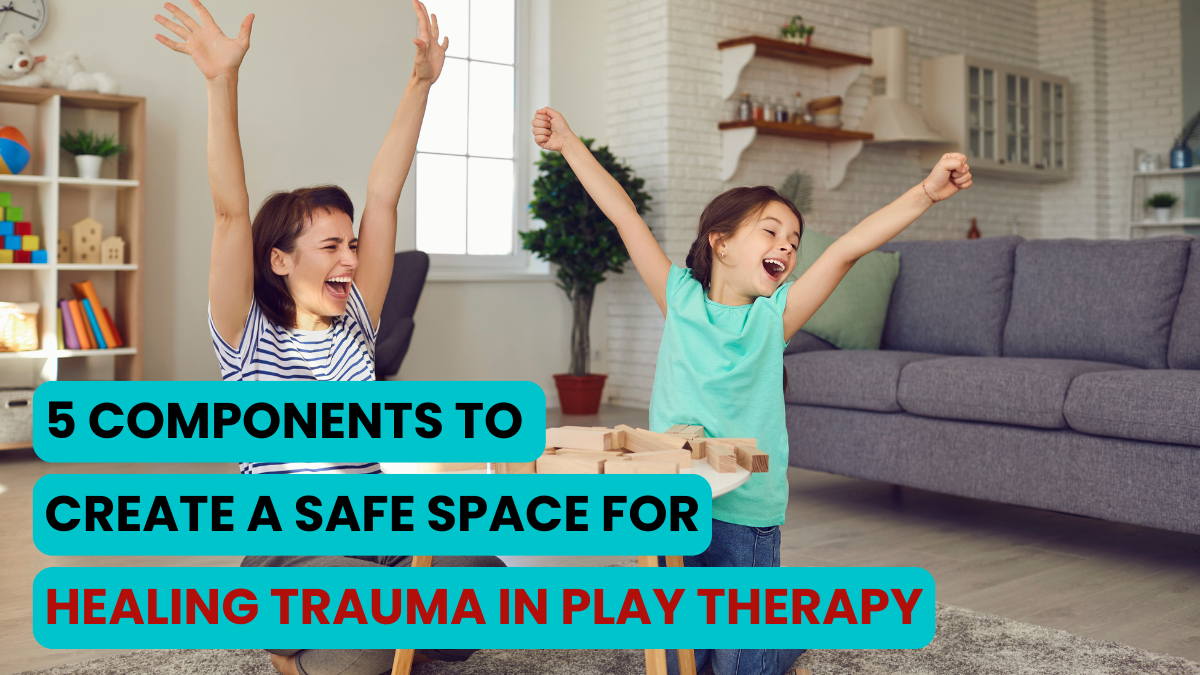5 Components to Create a Safe Space for Healing Trauma in Play Therapy

One of the most essential—but sometimes overlooked—elements of trauma-focused play therapy is creating a felt sense of safety in the therapeutic relationship. When a child has experienced trauma, they often enter the playroom on high alert, scanning for danger, not connection. Before any real therapeutic progress can take place, the child’s nervous system has to receive one clear message: you’re safe here.
Decades of research from neuroscience, attachment theory, and interpersonal neurobiology affirm what many of us know intuitively—healing starts with safety. As play therapists, our presence, tone, pace, and approach all matter. They either invite a child into connection or reinforce their instinct to stay guarded.
So how do we intentionally create a safe space for children in play therapy—especially those impacted by trauma?
That’s what we’re going to break down today.
The First Priority: Establishing Safety
When you’re working with trauma, regardless of the client’s age, the very first task is helping them feel safe—with you, in the space, and in the process. That therapeutic relationship is the container for healing.
Whether you use an integrative model, a specific play therapy approach, or something else, theory and science show us again and again: safety comes first.
And if you're wondering how to create that felt sense of safety, especially when trauma is in the mix, here’s what I recommend: the B5 Framework.
The B5 Framework for Play Therapy with Trauma
Here’s my 5-part framework to help you create safety in the playroom so your clients can access those powerful healing circuits through play.
1. Be Fully Present
You’ve probably heard me talk about this before. Being present isn’t just about sitting in the room with your client. It’s about internal stillness and tuning in so deeply that you’re picking up on those subtle cues—body language, energy shifts, micro-expressions.
When you’re fully present, you’re engaging your own neuroception circuits and syncing up with your client. Daniel Siegel calls this resonance circuitry—I just call it tuning in with your whole self.
And let me tell you, your presence is healing. When clients feel seen and felt—not fixed—they start to down-regulate those threat circuits. That’s where the healing begins.
2. Be Accepting and Empathic
This is where congruence comes in—really feeling that internal acceptance and unconditional positive regard for your client, and then showing up that way externally.
But let’s be real: being accepting doesn’t mean we never set limits.
Limits are necessary for everyone’s safety—child, therapist, toys, the space. They also help us show up with compassion instead of resentment. If something isn’t sustainable for you (like playing board games all day… nope, can’t do it), it’s okay to set a boundary around that.
What matters is that clients feel accepted, valued, and safe within those boundaries.
3. Be Curious
I love tapping into curiosity—what I call Columbo Mode (yes, I’m dating myself). When we get curious, we stay nonjudgmental, and we invite clients into exploration without pressure.
Instead of asking pointed questions, I might say, “I wonder what that was like for you?” or “Help me understand what you were thinking when that happened.” That tone of gentle curiosity gives clients permission to share—or not—while still feeling connected and in control.
Remember: asking questions = not child-centered play therapy. So be mindful depending on your model.
4. Be Playful
Play is how children do relationship. It’s their language. You don’t build trust with kids by talking first—you do it by playing. And in that safe, protected space, they’ll start to access those therapeutic powers of play.
Playfulness doesn’t mean being silly all the time. It means being attuned to the child’s world and joining them in it. For teens and adults, that might look different—you’ll build trust through conversation first and maybe add in expressive arts or other creative approaches.
Regardless of age, playfulness is a doorway to connection.
5. Be Aware
This is the thread that runs through it all—awareness of your theory model, your language, your body language, and the pacing of sessions.
Each play therapy model has a different approach to how you show up, especially in those early stages. Be aware of:
-
Your language (Are you inviting or interrogating?)
-
Your non-verbals (Where are you sitting? How close?)
-
Your pacing (Are you going too fast through tough material?)
Awareness allows you to respond instead of react—and that’s crucial for maintaining safety and trust, especially when trauma is involved.
Wrapping Up: Creating the Conditions for Healing
Let’s recap. When we help our clients feel safe, we’re not just making the space more comfortable. We’re actually helping their nervous system shift out of survival mode so they can access social engagement and, eventually, play circuits—which is where the healing truly happens.
The B5 Framework helps us do that by guiding how we show up:
-
Be fully present
-
Be empathic and accepting
-
Be curious
-
Be playful
-
Be aware
And the best part? This isn’t about perfection. It’s about intention. When we’re intentional about our presence and our approach, even the smallest moments in session can become healing ones.
Want to Go Deeper?
If this topic resonates with you, I’ve got a one-day training coming up:
Healing Trauma Through Play Therapy: A Neuroscience and Attachment Approach.
🗓 Saturday, May 17th
📍 In-person in beautiful Southern Utah
💻 Or join virtually from wherever you are
We’ll walk through trauma case conceptualization using neuroscience and attachment theory, explore each stage of change, and engage in experiential activities together.
Head to RHPlayTherapyTraining.com to register—and don’t wait if you want the early bird pricing!
Categories: : Attachment-Focused Family Play Therapy, Case Conceptualization, Congruence, Neuroscience of attachment, Play Therapy Model, Podcast, Trauma
 Cathi Spooner
Cathi Spooner 
